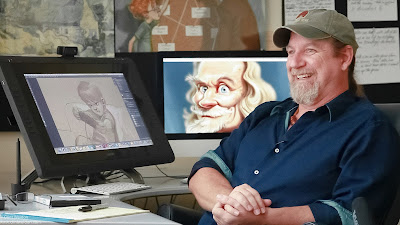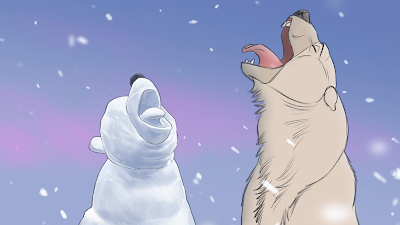A lonely bear can't find a friend, so he sculpts one.
Bring tissues to this small gem of a film. This is just a beautifully told tale that puts a smile on your face.
Yes this film kind of does what you expect, but those final moments and final images lift this film up to the statosphere. I went from smiling to sobbing in an instant.
One of the best films at Tribeca and 2025
---
I really love SNOW BEAR. It was one of the happiest films I’ve seen in a while. While I was talking to the PR people they asked if I wanted to speak to director Aaron Blaise and I instantly said yes. Because of the logistics of our schedules it was decided to do the interview via email. What follows are the questions I sent off to Mr Blaise and which he answered.
I want to thank Shaimaa Khan for arranging the interview and Mr Blaise for taking time out of his busy schedule to answer the questions of a fan.
STEVE: The promotional material said that this was a hand drawn film made over three years. Was it a one man operation or did you use many hands?
AARON:I created all of the visuals myself, everything from the layouts and backgrounds to the character animation, clean-up, effects animation, and editing. Once the visual side was complete, I brought on composer Mark Mancina along with Marlon E. Espino to create the score. For the foley work, I hired the incredibly talented John Roesch and Charles Kohlmyer. Finally, I worked with Mac Smith and his amazing team at Skywalker Sound for the sound design and final mix.
STEVE: Do you find it easier to direct alone or do you prefer a co-director?
AARON:It really depends on the size and scope of the project. Directing a feature-length animated film is a massive undertaking, and having a co-director to help carry that workload can be incredibly valuable. That said, directing solo has its own rewards. It allows for a more unified vision, with fewer compromises along the way. A good director will always be open to creative input from the team, no matter where it comes from, but ultimately, it’s their responsibility to make the final call. When working with a partner, you get the benefit of two creative minds, which can be a great asset. Of course, it also means navigating differing opinions, which can sometimes be a challenge.
STEVE:When you got the idea for the film did you have it all together or did it grow from pieces? How much did you have from the original idea?
AARON: The idea started with a simple image: a lonely polar bear living in the Arctic who just wants a friend. When he’s unable to find one, he builds a snow bear for companionship. That was the seed that sparked everything. From there, we explored the emotional and playful possibilities of having a snow bear as a friend, which led to some fun and heartfelt moments. The ending, however, took a while to discover, we went through quite a bit of exploration before landing on the one that felt right. Interestingly, the environmental aspect of the film wasn’t part of the original concept. That layer emerged naturally as the story developed and began to take shape during production.
STEVE: At what point did you know what the ending was going to be?
AARON: The ending really took shape during the final year of production. I explored several different versions in storyboard form before settling on the one that ultimately made it into the film. It was a process of trial and error, trying to find the emotional tone and narrative resolution that felt most honest to the story we were telling. It wasn’t something I had figured out from the beginning; it evolved as the characters and themes deepened over time.
STEVE:Since the animation of the animals seems flawless and natural beyond just the “cartoon”. I was wondering how much research you did into the motion of the various animals?
AARON: I've been studying animal anatomy and movement throughout my entire artistic career, it’s truly my first love. In fact, I initially aspired to be an illustrator for National Geographic before discovering animation. The natural world, and animals in particular, have always been where I feel most creatively fulfilled. So, animating a polar bear and other wildlife in Snow Bear felt like second nature to me.
My experience directing Brother Bear 20 years ago provided a solid foundation in animating bear locomotion . For Snow Bear, I delved deeper into the specifics of polar bear movement. I conducted extensive research, including reading scientific literature, watching documentaries, and observing polar bears in person at zoos . This meticulous study ensured that the animation captured the authentic weight, rhythm, and subtle nuances of real polar bear behavior.
STEVE:IMDB says your next project is TEMBO, is there anything you can say about it?
AARON:The Legend of Tembo was a film I began directing about 13 years ago while working at Digital Domain’s Tradition Studios in Florida. Unfortunately, the company filed for bankruptcy in 2012, leading to the closure of the studio and the project's cancellation . It was a heartbreaking experience, especially considering the incredible team and the passion we poured into the film. Despite the setback, the experience remains a significant part of my journey as a filmmaker.
STEVE: I was curious about what your artistic influences were in making the film. I get a sense of Chuck Jones and his Rikki-Tikki-Tavi, and I see echoes of the Pines of Rome in Fantasia 2000, but were there others?
AARON: My biggest influences in animation come from the classic Disney era, particularly the work of the Nine Old Men, legendary animators like Milt Kahl, Frank Thomas, and Ollie Johnston. Their mastery of character animation and storytelling has profoundly shaped generations of artists, myself included. Ollie Johnston, for instance, was renowned for infusing his characters with warmth and heartfelt emotion, emphasizing the power of subtle gestures in conveying relationships. Among contemporary animators, Glen Keane has been a significant influence on my work. His ability to bring characters to life with emotional depth and authenticity is unparalleled. Glen's work has been instrumental in defining the modern era of Disney animation. Mark Henn is another animator whose work I deeply admire. Known for animating some of Disney's most iconic characters, including Ariel, Belle, and Mulan, Mark's commitment to sincerity and warmth in his animation has left a lasting impact on the industry . James Baxter's fluid and expressive animation style has also been a source of inspiration. His work exemplifies the blend of technical skill and emotional resonance that I strive for in my own projects. These artists have each contributed uniquely to the art of animation, and their legacies continue to inspire my approach to storytelling and character development.
STEVE: The film has a sense of humanity and sensibility that transcends what we normally think of in animation. Where did you get that sense of life and feeling?
AARON: All of my stories are rooted in my own experiences, and Snow Bear is especially personal. Eighteen years ago, I lost my first wife, Karen, to breast cancer. Her passing was devastating and left me emotionally adrift for a long time. Watching someone you love succumb to an illness like cancer is an incredibly helpless feeling, as you see them gradually fade away. After Karen's death, I experienced profound loneliness and a lack of direction. But over time, I found my footing again and, eventually, found love once more. Snow Bear is a metaphor for that experience. Karen inspired this film and will always hold a special place in my heart. Snow Bear is my gift to our children and the grandchildren she never had the chance to meet.
STEVE: Who are your favorite directors, both in animation and live action?
AARON: I'm a huge fan of the Coen brothers, especially The Big Lebowski and O Brother, Where Art Thou?. I admire their ability to blend humor, music, and character-driven storytelling in such a distinctive way. O Brother's use of folk music and its modern take on classic mythology are particularly inspiring to me. Steven Spielberg is also at the top of my list. His mastery of visual storytelling and his ability to evoke deep emotional responses have been incredibly influential on my own work.
In animation, Hayao Miyazaki stands out as my favorite director. His films, like Spirited Away and Princess Mononoke, are rich with imagination, emotional depth, and a profound respect for nature.
STEVE: What film(s) move you to tears in the way that SNOWBEAR moves the members of its audience?
AARON: My favorite films tend to have heavy themes portrayed in ways that gently pull the viewer in.
The most recent film to evoke a similar emotional response was Tuesday, a poignant and imaginative story about a mother coming to terms with her daughter's impending death. Julia Louis-Dreyfus delivers a remarkable performance as Zora, a mother grappling with grief and denial, while Lola Petticrew portrays Tuesday, her terminally ill daughter. The film's unique portrayal of Death as a talking macaw adds a surreal yet deeply moving layer to the narrative, blending dark humor with emotional depth. Another film that resonated deeply with me is His Three Daughters, directed by Azazel Jacobs. This intimate drama centers on three estranged sisters, played by Carrie Coon, Elizabeth Olsen, and Natasha Lyonne, who reunite in their father's apartment as he enters hospice care. The film masterfully explores the complexities of familial relationships, grief, and reconciliation, all within the confines of a single setting. The performances are exceptional, capturing the raw emotions and tensions that surface during such a challenging time. While both films tackle heavy themes of loss and acceptance, they do so with sensitivity and authenticity, inviting viewers into deeply personal journeys that leave a lasting impact.




No comments:
Post a Comment